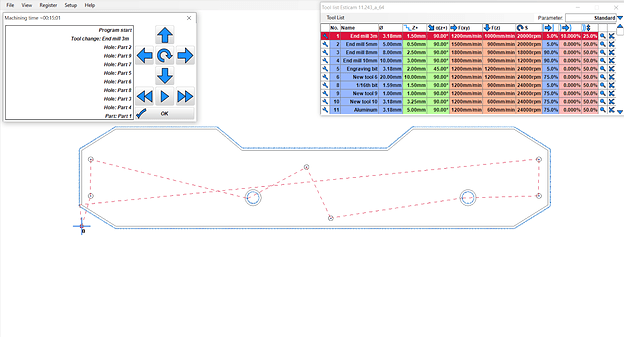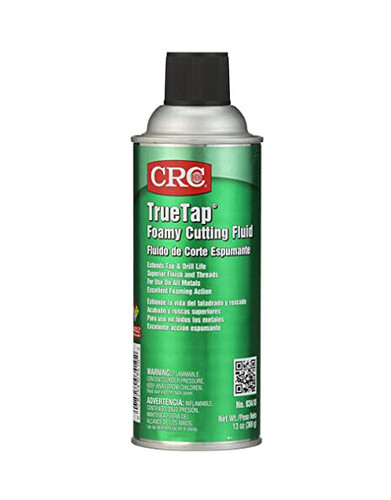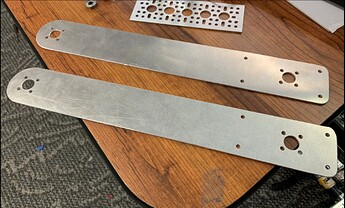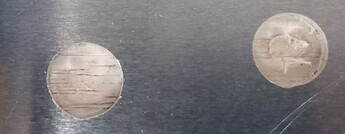I’ve been doing research on cutting aluminum with an MPCNC and its often mentioned that I should I use trochoidal milling. I’m currently planning on cutting a thin piece of aluminum (.09 inches). Do I need to use trochoidal milling or is it thin enough to use standard milling? Thank you!
I think this depends on your rigidity and the endmill you’re using. I’ve slotted with my very small mpcnc at 0.04" passes using an extra roughing pass for anything thicker than 1/16. You might be able to get away with it, but I think you’re just gonna have to take a swing and see.
Are you trying to avoid trochoidal for any reason?
If you post a picture of the part you want to cut, you can probably get a lot more input towards strategies to try, and potential pitfalls to watch out for.
Thank you for your response, I’ll experiment with some test cuts when I’m back with my cnc.
The only reason I would like to avoid trochoidal milling is to lower cut time, but other than that I’m happy to run cuts with trochoidal milling. This particular cut wouldn’t even take too long with trochoidal milling (once I get the right feeds and speeds, I assume the cut will still be under 40 mins)
Since I’m new to cutting aluminum, I’m just trying to learn about my options.
I don’t have my material with me right now, but I can get a picture of it on Tuesday.
If the material starts to flutter, you may have luck sandwiching it between something sacrificial, like 1/4" MDF.
Thanks, I’ll make sure to try this
Also blue tape amd super glue, although I’ve had some trouble scraping the tape off-the tape tends to tear around the hardened glue.
That part looks like a great starting point for aluminum.
Another thing to consider about the time, is that these steppers aren’t super powerful, and if the aluminum gums up on you at all, you are fairly certain to lose steps and scrap the job, so troichoidal can actually save time (and money) where it prevents job failure.
This one should be pretty simple to do with slotting, though. Good luck!
The other option is the blue tape and superglue sandwich, that should be great at holding all of the thin material down. Trichodial is safe, if you want to try without it take lots of test cuts and learn what works best for you. Metal has a smaller feeds and speeds window that works than wood so once you get it close you really need to try smaller and smaller steps (5mm/s steps, 1mm/s steps, stepover percentages, and depth) to make the best surface finish. Once you have some numbers that work for your setup you can use them in all your projects going forward.
If this is something you plan on doing more of, and have a compressor, a cheap mist system shooting a tiny bit of IPA works miracles in my experience.
Good to know that the super glue method works for aluminum as well. I have a compressor and I was going to use this cutting fluid spray for now
Well, fluid it self can really make the chips stick in place and makes a mess. The air getting the chips out of the way is probably the biggest help. Unless you are flooding it, I am not sure how much that fluid will help. The IPA is nice because it cools and evaporates at the same time. So The chips still get kicked out easily.
That would be IsoPropyl Alcohol from a mister for the machine. India Pale Ale from a bottle for the operator seems to help a bit, too.
Mist cooling is the way to go imo for our usual setups. Personally I use Trim Mist (mixes down with water) on my setups (CNC and manual machines).
I wonder how boost juice or winter windshield washer fluid would work.
Keep in mind that aluminiums material properties can vary. Some alloys are softer and more prone to stick to the endmill than others. Good luck!
The liquid is not the important part here with aluminum, clearing the chips out, so you do not re-cut them is. Focus more on the air or vacuum removing the chips from the cut rather than the liquid. Aluminum cuts and is gummy and will stick and pack the cut, if it gets out of hand it will stick to the cutter.
Fluid is not necessary with aluminum.
Yes I am sure some 6061 0 temper would be fun. I wonder how 2024 t3 would work.
I would recommend sticking with trochoidal. In my experience with aluminum (which is pretty-much all I cut with my MPCNC) trochoidal milling is safe and consistent. My experience with trying to do slotting in aluminum for any significant distance has always resulted in chip-weld, the bit gumming up or breaking and a ruined part.
For that part I would go with a single-flute 1/8" kyocera bit, do a single trochoidal pass with tabs, and adhere the stock to the spoiler with blue-tape and ca-glue. You could probably get away without the tabs, but I like to reduce the possibility of the part coming loose as much as possible. Honestly, if the stock allowed me to also clamp it down I would probably do that as well - last thing you want is something shifting in the middle of a cut.
Good luck - I’m confident you’ll get a decent result. I’ve been quite pleased with the results I get on parts like that (although I’m usually using 1/4" aluminum with 2 passes).
Oh BTW - I don’t use any cutting fluid with the trochoidal cutting, and the only air flow is from a shopvac I have setup for chip extraction…
On a wood/plastic cnc with garage standard fixtures? It depends… a part like the one drawn above probably OK, but I bet most 3d operations would be just as fun as O temper.
I was going to work on and get pictures of my aluminum yesterday, but I got a little sick, and I wasn’t able to visit my HQ. I’ll try again with the aluminum when I get the chance and I’ll get back to you soon. Thanks again and happy thanksgiving to you all!
I was just talking about the differences I have seen when shrink stretching 6061 0 to 2024 t3.
The 0 is so smeary and plugs up a lot. 2024 springs back and I would imagine chips out nice. It’s just something I wanted to try grabbing some off cuts from work.
I cut two parts with trochoidal milling then used a sander to clean them up (These are different from the part I was originally planning to cut). These cuts were about 18 minutes each with one pass and they went pretty well.
The biggest issue I ran into was that the holes were too small, and my screws and bearings wouldn’t fit until I drilled them out. I cut some more holes in the remaining aluminum and like the ones on my parts, these holes had a little dent on the edge where the bit went into the aluminum (The dents were bigger on the parts that I cut out and I assume the dents are smaller on these holes bellow since I added a finishing pass) and they were still too small. This has happened in Wood and Lexan as well.
Overall, it went better than I expected, and I’ll keep working on getting my holes the right size



